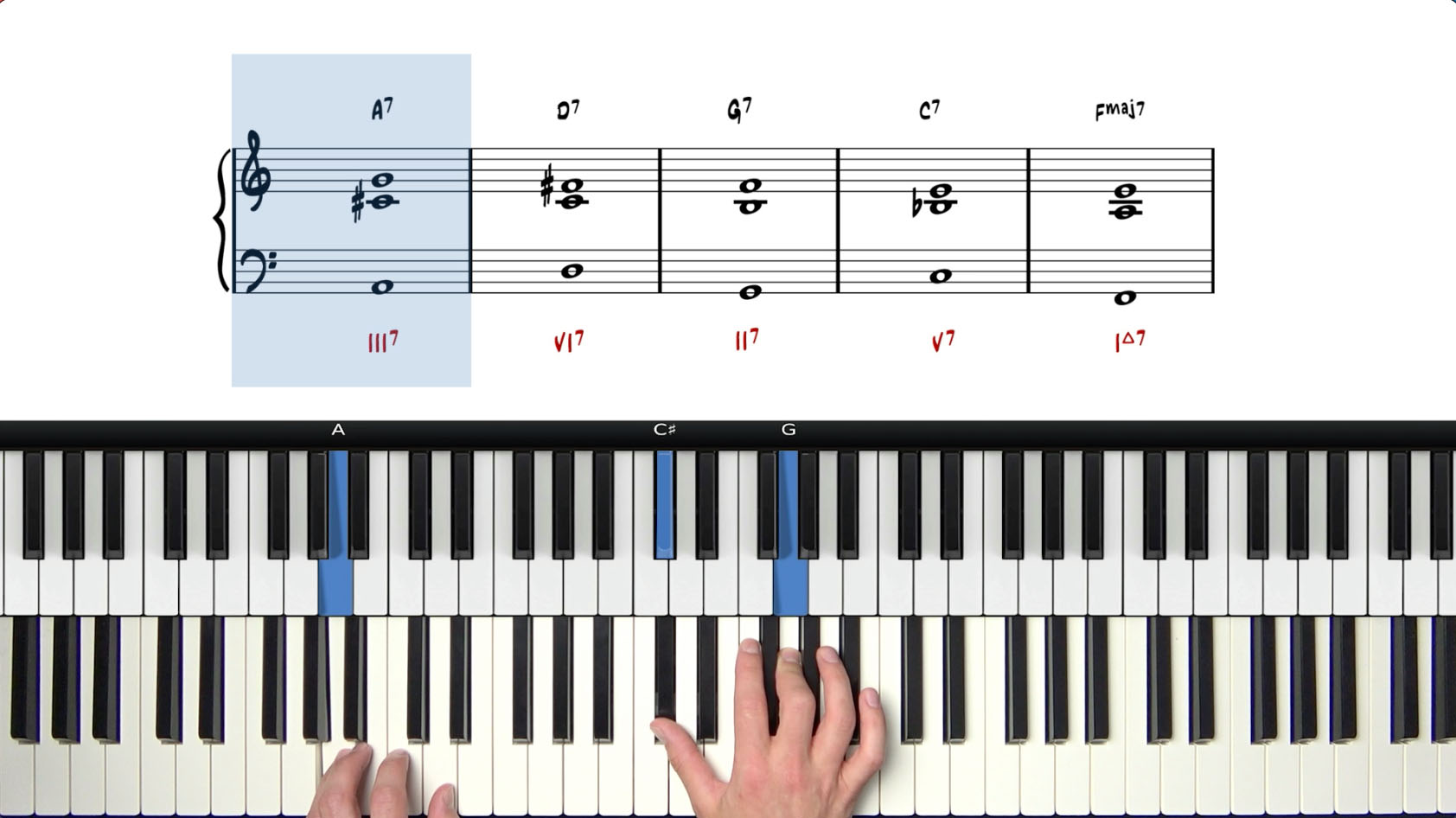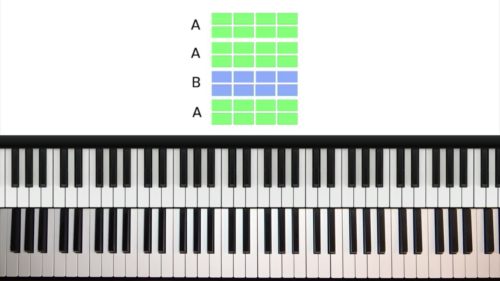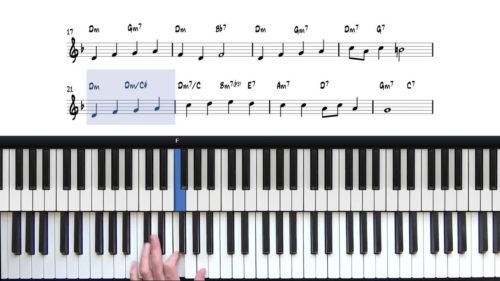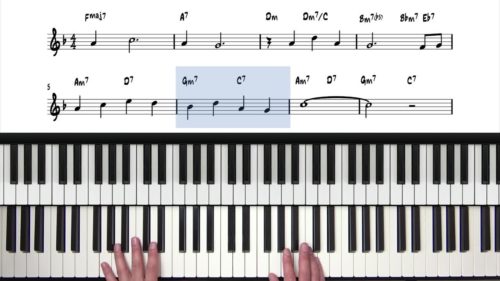How to Read Lead Sheets: “Georgia”
Welcome to this beginner jazz piano tutorial on the tune “Georgia On My Mind”. In this lesson we will learn how to arrange the A Section of the tune using spread voicings.
How To Play Spread Voicings
The most basic technique to arrange a lead sheets is to use spread voicings. To construct a spread voicing, we take the notes of the any 7th chord, we play the root note of the chord in our left hand in the lower registers of the piano, we play the melody with our right hand, and we ‘voice’ the 3rd and 7th of the chord in between.
The 3rd and 7th can be played in either hand, often this role will be shared between both hands to achieve an even spread of notes on the piano and balanced sound in our voicings.
Georgia In The Key Of F Major
Georgia is written in the key of F Major and so we quick recap of the diatonic 7th chords and the common chord progressions in the key of F such as the 251 and the 36251 progressions. The notation can be found in the Downloads section below.
Having an understanding of F major diatonic harmony is very useful when arranging Georgia and other tunes written in F major.
The Full Course
This lesson provides an introduction to reading lead sheets using the tune “Georgia”. Check out the our beginner course Bluesy Stride Piano For Beginners for a step-by-step series of lessons where we arrange the entire tune.
Lesson Downloads
-
F Major Diatonic Workbook File Type: pdf
Practice Tips
-
To voice a chord with spread voicings, play the root in the lower register, the melody with your right hand, and then find the 3rd and 7th in between.
-
Outline the quarter note pulse in your left hand to help to you transition to the stride left hand style.
-
Understand that the tunes that we play are always in a fluid state and as we learn new theory and as we develop as musicians we are always enhancing and tweaking our arrangements.
-
Memorise the chords and the melody of the A Section. This might take a few days or a few weeks and once memorised you will be able to play the tune without the lead sheet.







Great foundations lesson to begin adding stride, spread voicing and grace noting in a step by step format. Fundamentals of arranging from a lead sheet. Very well done. Going to spend some time on this one.
Thanks for the feedback Rick, I’m glad you find the lesson useful.
I am building out a full course on this tune which further explores the topics covered in this video, find the course here: https://www.pianogroove.com/jazz-piano-lessons/bluesy-stride-piano-beginners/
Those lesson will follow on very nicely from this introduction so be sure to check them out.
As I mention we are playing these tunes all of our lives and so in these lessons I try to show the many different ways that we can interpret a tune so that we don’t have to play it the same way every time.
Cheers, Hayden
Thanks – this is great. I like the harmony visualization – would doing a Roman Numeral analysis help understanding the harmony as well – very helpful for example when you mentioned that the B section switches to the relative minor. I have tried to do some Roman numeral analysis with mixed success, particularly when there are key changes for a few bars in some tunes. I tried to do for Unforgettable and was totally lost. Have you ever thought about including on the lead sheet or in a harmonic analysis? Could you do it for Georgia? Started to try to do as well to help memorize standard.
Hi Rick,
Yes this is a great idea, I will add the numerical analysis lesson to the “Bluesy Stride Piano/Georgia course” – I agree it’s very helpful information and it will be a nice addition to the current lessons.
I will be able to get this lesson recorded this week.
Cheers, Hayden
This is great. I’ve practiced these voicings from Georgia a LOT and finally they are starting to come naturally which is a great feeling. I’m adding embellishments which is fun. For some reason I don’t like stride left hand. But you never know. It might grow on me. I may be getting somewhere. Thank you!!
Hey Elizabeth 👋
I’m really happy to hear of your progress! It’s exactly that; lots of repetition and then the voicings will come naturally.
I’m adding many more lessons to this course to show the many different ways that we can interpret the tune. The goal is to give students a little more freedom when playing so that we can make more spontaneous choices on how to play through the changes.
Nobody has asked for a transcription of the voicings, which I deem to be a great sign as what I’m trying to teach is how to memorise and internalise the tune and harmony so that we don’t need to rely on notation. This way we are playing jazz piano in its true form!
More lessons to follow so stay tuned!
Cheers, Hayden
I know you want us to not need a transcription of the voicings but at this stage I think it would be really helpful for me to have just that. So far the course has been excellent, but I now want to study the voicings of Georgia in detail and for me that means either watching the relevant parts of the video over and over or looking at the score. I find the video controls very frustrating as they are extremely hard to use on an iPad (setting up an AB loop almost impossible even with the ‘I’ and ‘o’ controls).
Hi Gill.
Yes I can certainly create a transcription for you if it would be helpful. One does already exist on this more advanced lesson for Georgia – https://www.pianogroove.com/blues-piano-lessons/georgia-on-my-mind-tutorial/ – look in the downloads section.
The problem with transcriptions is that the temptation is there to simply read the notes like a piece of classical music. With this course I try to show the many options that we have for voicing the chords so that we are not reliant on a transcription. But leave it with me and I will create some voicing charts that can be used for reference.
Thanks for letting me know about the video player. I know that the developer recently made some additions with the I and O controls. I have asked him to check over on iPad.
Another option is to connect a keyboard to your iPad either via the cable or via bluetooth and then you can press the I and O buttons on the keyboard.
I will get back to you shortly with an update from the developer and hopefully he can improve the on-screen buttons.
Cheers, Hayden
Thanks Hayden, that’s really helpful! I’ll look forward to the improved video controls and will take a look at the download you’ve suggested. I am very much still in ‘classical so need everything written down’ mode, and understand that I need to break out from that, but i do think that at this stage the voicings of the basic arrangements would help me to learn. Thanks again, I have done this course to compare against a rival online course that I’ve been working with for a while now and I can honestly say that I’ve got a much better understanding of the basics from your course. So much so that I plan to drop my subscription to the other course 👍
Thanks for looking at controls. Have had same difficulty and in general. The buttons are sensitive and many times end of advancing vs hiring relevant function.
Thanks for the feedback Rick – I have passed it onto the developer..
Last night I played around with the new ‘I’ and ‘O’ buttons on my iPhone and they are not responsive at all for me either.
I have asked the developer to look into this.
I had the idea of displaying to the default Vimeo embed for users on mobile/tablet. This would remove the A/B loop for these users completely, and we would just keep those settings for the users on laptop/desktop where the features work more reliably.
It’s a bit of work to change all of the embed codes for all lessons, but I think it would give more stability for users on touch screen devices so that they can play and pause the video reliably.
Cheers, Hayden
Thank you, this is just great. I thought the point of the lesson was to look at the changes, figure out whether the melody note is in the chord, and then doing a simple shell voicing (with or without adding the fifth)with good voice leading across both hands. That simple exercise alone is mentally exhausting! I find myself so focused on the chord at hand that I forget where my left hand was during the previous chord!
I think it’s easier to play rootless Bill Evans chords in the left hand while playing the melody in the right hand, – But not nearly as musical.
It would be fabulous if you could take us through the entire 8 bars of this or any other standard doing just that exercise out loud. One day (soon?) I will add stride, but at this stage, I’d love to see how to make my way through a tune doing just the exercise you started the lesson with. Baby steps! Wonderful course.
Thanks for the comment Jeremy and I’m glad to hear that you are enjoying the course.
I structured this course to show the many options that we have when playing solo piano. These exercises do take time but by revisiting them on a regular basis you will see rapid improvement.
Once we can visualise these chords in their basic positions, this sets strong foundations upon which we can introduce stride and many other left hand devices.
You might also like to start the “Misty Cocktail Improv” course which covers the same process for the tune “Misty” in the key of Eb Major, and we also introduce improvisational drills too: https://www.pianogroove.com/jazz-piano-lessons/cocktail-improvisation-for-beginners/
Enjoy the lessons and happy new year!
Cheers, Hayden
This progression is in F then why is there a D7. Why is there an F# sounds right but I don’t know why Also this lesson won’t let me play the last 3 sections. It keeps reverting to the beginning? Is it something I am doing wrong? Thanks
Hi Elizabeth,
The D7 is the VI7 chord in the key of F major, please see this lesson for more information: https://www.pianogroove.com/jazz-piano-lessons/diatonic-7th-chords-in-f-major/ – in major keys it’s common to plat the VI chord as a dominant chord and not a minor chord. This is where the F# comes from. Watch the lesson above and it should all make sense for you.
This chapter issue has now been fixed, apologies for the issue. The wrong video file was displaying. The correct video is now in place.
You might also like to start the course on “Georgia – Bluesy Stride Piano For Beginners” you can find that course here where we go through the harmony in more detail: https://www.pianogroove.com/jazz-piano-lessons/bluesy-stride-piano-beginners/
Let me know if I can help further and enjoy the lessons!
Cheers, Hayden
I’ve been doing a number of advanced lessons but circled back to this foundations course and found it enormously helpful. This lesson, in particular, was really fun. Thanks!
On another (rather trivial) matter, I changed my name in the account from “Gilbert’ to “Gib” but can’t get it to change in things like comments. How do I do that?
Gib
Hi Gib,
Thanks for the feedback and I’m glad you are enjoying this course. It’s a lovely tune to play. I plan to add some more harmony lessons and a full improvisation module to this course in the near future.
I have just changed your ‘username’ to Gib and this is now reflected on the website. Let me know if I can help further with this and enjoy the lessons!
Cheers, Hayden
Hi Hayden – This foundation lesson is motivating, I appreciate how well you explain the chords vocings and the learning process. I am making progress and feeling really good about it.
Cheers!
Hey Orlando 👋
Thanks for letting me know and I’m glad you enjoyed the lesson. This lesson is a shorter summary of the full course on “Bluesy Stride For Beginners” which you can find here:
https://www.pianogroove.com/jazz-piano-lessons/bluesy-stride-piano-beginners/
I recommend to get started with the course immediately and it will help you to see the many steps involved with learning to play a tune from a lead sheet.
I also recommend to get started with the cocktail improvisation course which follows a similar format but with a focus on improvisation: https://www.pianogroove.com/jazz-piano-lessons/cocktail-improvisation-for-beginners/
Spend a few weeks on those lessons and let me know how you get on.
Any questions just let me know.
Cheers, Hayden
Yay Hayden!!
You sound so GREAT!!!
I’m so glad to be back and hearing you play so well!!
Megan
Thanks Megan, I’m glad you’re digging the arrangement.
I’ve been trying to infuse my solo jazz piano playing with some of the nuances of New Orleans blues which is fun!
Hi Hayden
I’m a beginer (in fact still on your trial week!). I have started your first course and find it extremely absorbing and beautifully explained. It is wonderful the way you include standards right from the start. I have two very basic and fundamental questions:
Arun
Hey Arun 👋
I’m glad you are enjoying the lessons!
Yes you are correct that the relative major and minor share the same key signature.
The easiest way to tell what key a tune is in, is to look at the first chord and even better the last chord. In many cases, jazz standards start on the 1 chord, in this case Fmaj7, which gives us an indication that the tune is in the key of F. It’s worth noting that tunes can start on other scale degrees, for example, it’s also fairly common for tunes to start on the ii-7 chord of the key.
This is why I said the best way to identify the key of the song, is to look at the last chord. This is where the song resolves, and as we see in Georgia, the tune finishes on Fmaj7 and so the song is written in the key of F.
When a tune starts and ends on the same chord, it’s usually a very solid indication that the chord is written in that key. In this case F Major.
Another thing to note is that tunes often modulate, and in the case of Georgia, there is a modulation in the bridge to the key of D Minor, which is the relative minor. It’s fairly common for jazz standards to modulate to the relative minor in the bridge/B section.
We know that the tune has modulated because the bridge heavily features D minor, and also G-7 which is the iv chord of D minor, and so the tonality is predominantly minor in the bridge.
If we play the A section of the tune, it predominantly has a ‘happy and cheerful vibe’ which is characteristic of major keys. Conversely, when we play the B section of the tune, it has a much darker and sadder vibe.
Regarding your question with natural/melodic/harmonic minor, you should check out this course:
https://www.pianogroove.com/jazz-piano-lessons/minor-harmony-improvisation/
I like to look at the different minor scales simply as a different ‘flavour’ or ‘colour’ of the same minor key. There is only 1 or 2 notes different between them which adds the slightly different flavour.
When playing in the key of D minor, as the arranger, or the improviser, we can choose if we want to bring out the colours of the natural minor, or as more commonly found in jazz music… accentuate the colours of the melodic and harmonic minor.
If you watch the course above that should all make sense to you.
Conveniently, the tune we work on in that course is also in the key of D Minor.
I hope that helps Arun.
Talk soon, cheers, Hayden
Hi Hayden,
Thanks so much for your immediate response and was very happy to go through your course (though not finished) on minor harmony improv.
So does this mean when we see a key signature, understand that it is on the relative minor (as in Sentimental Mood), the player or arranger has the freedom to choose to play natural, harmonic or melodic depending on how he wishes to colour the improv ?
Arun
Hi Arun,
Yes that’s exactly right. I like to view the different minor scales simply as a ‘different colour’ of the same minor tonality.
You might like to check out these forum threads which discuss minor harmony and minor scales:
https://community.pianogroove.com/t/practicing-minor-scales/2423
https://community.pianogroove.com/t/the-natural-6-13th-over-minor-chords/1572
You will see in the “Essentials Practice Guide” that I recommend to practice the Dorian Mode which is another minor scale: https://www.pianogroove.com/jazz-piano-lessons/essentials-practice-guide-simplified/ – this is the simply the major scale with b3 and b7 and i explain why I recommend to practice this minor scale in the forum threads above.
After you watch the lessons in the minor harmony and improvisation course, you will understand when and why we might use the a particular minor scale in a particular scenario.
Here to help if you have any further questions.
Cheers, Hayden
Thanks Hayden,
I’ll certainly check out those forum threads. Just one quick question. When practicing the minor scales, for the Harmonic Minor, we raise the 7th degree by half step, whereas for the Melodic Minor, we raise the 6th and 7th degree half step only when ascending, A descending Melodic Minor is the same as a Natural Minor. Right ? So how is that applied during improv ? Thanks
Arun
Hi Arun,
Please check out the minor improv course that I suggested to you, in particular module 3 which contains these 3 lessons:
5-note scale improvisation: https://www.pianogroove.com/jazz-piano-lessons/triad-improvisation-beginners/
Melodic minor scale improvisation: https://www.pianogroove.com/jazz-piano-lessons/melodic-minor-improvisation/
Harmonic minor scale improvisation: https://www.pianogroove.com/jazz-piano-lessons/harmonic-minor-improvisation/
That should answer all of your questions with regards to how this material can be applied in improvisation.
Cheers, Hayden
I’m really struggling with this one : not sure what to ask to be honest… Just struggling… I’m pretty much okay with the other one, Tune Up, I can play that…
I can play the first two bars of this (the Fmaj7 and A7 bit) but I’m not very good at the slithering hand thing that’s going on, that feels very advanced 🙁
Once it gets to the next two bars I just can’t really get it and I don’t really know what to do or what to practice to get through this 🙁
Hi Thomas,
Did you check out the step-by-step course on this tune? You can find it here: https://www.pianogroove.com/jazz-piano-lessons/bluesy-stride-piano-beginners/
This lesson does incorporate more advanced theory, just to show how far we can take a tune. Don’t be intimidated by it, it’s simply to show what you will learn in the upcoming courses. Towards the end of the video it is advanced just as a taster of what’s to come.
As a beginner, I recommend that you check out the 3 jazz standard lessons:
https://www.pianogroove.com/jazz-piano-lessons/pure-imagination-for-beginners/
https://www.pianogroove.com/jazz-piano-lessons/nearness-of-you-for-beginners/
https://www.pianogroove.com/jazz-piano-lessons/days-of-wine-roses-for-beginners/
We stick to more beginner-friendly theory in these lessons.
You might also like to watch this seminar which highlights the most important theory milestones for beginner/early intermediate jazz students:
https://www.pianogroove.com/live-seminars/jazz-voicings-for-beginners/
Please check out those lessons and let me know if I can help further.
Cheers, Hayden
Thanks Hayden, I’ll spend some time with those first and then come back to this!
I think you meant to post 3 different links for those 3 standards though, whereas you posted “nearness of you” twice!
That’s alright though, plenty to go on with for now, thanks!
Thanks for letting me know Thomas – I have corrected the duplicate link in my comment above.
The third tutorial I wanted to send you to is “The Day Of Wine & Roses”: https://www.pianogroove.com/jazz-piano-lessons/days-of-wine-roses-for-beginners/
These 3 tutorials are in our beginner jazz arrangements course: https://www.pianogroove.com/jazz-piano-lessons/beginner-jazz-piano-arrangements/
Set a goal to learn 10 or so jazz standards. The more tunes we learn, the easier it becomes to learn the next ones.
Focus on learning lots of new tunes, and also learning some of them in more detail by following our dedicated jazz standard courses such as:
Cocktail Piano Improv: https://www.pianogroove.com/jazz-piano-lessons/cocktail-improvisation-for-beginners/
Ballad Voicings & Fills: https://www.pianogroove.com/jazz-piano-lessons/ballad-voicings-fills-improv/
These 2 courses are mixed level, and so you will encounter more advanced theory, and also techniques which might be challenging for you to play similar to this lesson on “Georgia” towards the end . Don’t be disheartened by this, it’s a process. I have been playing these tunes for many years and there is always more to learn and ways to develop our arrangements. It’s an ongoing process.
I hope that helps and talk soon, Hayden
Hello Hayden, this course has a The Key Of F Major: Diatonic Workout which is very useful for a beginner like myself because having been taught classical i can read the sheet music, and am able to at least learn these voicings, is there a place to get other keys ?
Hi Dalian,
Yes we cover the same drills in Eb at the start of our Cocktail Piano Course: https://www.pianogroove.com/jazz-piano-lessons/cocktail-improvisation-for-beginners/
You might also like the first module of the Ballad Voicings & Fills course which covers spread voicings in F Major: https://www.pianogroove.com/jazz-piano-lessons/ballad-voicings-fills-improv/ – these drills can be applied to any jazz standard that you are working on.
Finally, check out this course on Functional Harmony which explores common progressions in C Major: https://www.pianogroove.com/jazz-piano-lessons/functional-harmony-course/
I would recommend to study those 3 keys as they are very common for jazz standards. I have made a note to cover drills like this in all keys in our upcoming lesson schedule.
Check out the lessons above and let me know if I can help further.
Talk soon, Hayden
Enjoying working on Georgia, Hayden. Always wanted to learn stride. Thank you for your meticulous instruction. I need to go over and over it. My wife leaves the room. So now I have ear pods.😁🎶🎶Bill